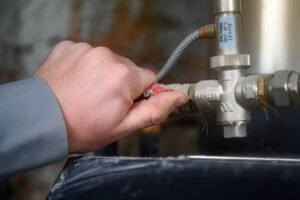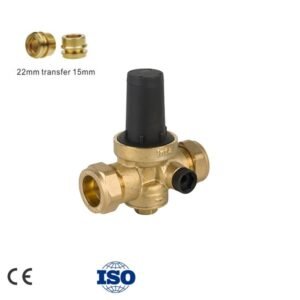Overview
Thermostatic Mixing Valves (TMVs) are vital components in plumbing systems, designed to deliver water at a consistent and safe temperature by mixing hot and cold water to a pre-set level. These devices are crucial in preventing scalding and ensuring comfortable water use across various applications, from residential bathrooms to commercial healthcare facilities.
Functionality of TMVs
TMVs operate through a temperature-sensitive element that adjusts the balance of hot and cold water in response to changes in water supply conditions. This element, reacting to the mixed water’s temperature, expands or contracts to modify the valve settings, thus stabilizing the output temperature despite fluctuations in pressure or supply temperatures.
Safety Features and Compliance
Safety is a paramount concern with TMVs, especially in environments serving vulnerable populations such as children and the elderly. TMVs feature fail-safe mechanisms that shut off water output if either hot or cold water supply fails, thus preventing extreme temperature water from causing harm. These valves adhere to standards like BS EN 1111:2017 and BS EN 1287:2017, which dictate stringent safety and performance criteria.

Advantages of Using TMVs
- Scalding Prevention: TMVs maintain safe water temperatures, reducing the risk of burns from overly hot water.
- Conservation of Energy: By controlling water temperature precisely, TMVs help reduce the energy consumption associated with heating water.
- User Comfort: Consistent temperatures improve user experience, particularly in showers and baths.
- Compliance with Regulations: TMVs help facilities meet legal safety standards, often required in public buildings, healthcare settings, and schools.
Installation Tips
The correct installation of a TMV is key to its effectiveness. It involves understanding the water pressures and temperatures, ensuring the valve is installed close to the point of use to prevent temperature loss in long pipes, and placing the valve in an easily accessible area for ongoing maintenance.
Maintenance and Servicing
TMVs require regular maintenance to perform optimally, recommended annually, to check and recalibrate the valve as necessary. This ensures they continue to function as intended, providing safe, regulated water temperatures under all conditions. Maintenance checks include testing the valve’s response to changes in supply conditions and replacing parts as they wear.
Conclusion
Thermostatic Mixing Valves are more than just plumbing components; they are a critical safety feature in modern water systems, providing consistent temperatures, energy efficiency, and compliance with health and safety regulations. Implementing TMVs across suitable facilities not only promotes safety but also enhances the operational quality of water heating systems, making them an indispensable feature in both new and renovated plumbing installations.






